When Was A Camera Invented
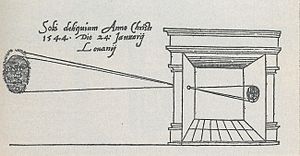
First published picture of a camera obscura in Gemma Frisius' 1545 book De Radio Astronomica et Geometrica
The history of the camera began even before the introduction of photography. Cameras evolved from the photographic camera obscura through many generations of photographic applied science – daguerreotypes, calotypes, dry plates, moving picture – to the modern mean solar day with digital cameras and camera phones.
Camera obscura (11th–17th centuries) [edit]
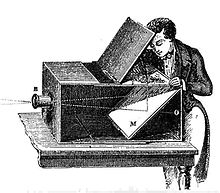
An artist using an 18th-century photographic camera obscura to trace an image
The forerunner to the photographic camera was the camera obscura. Photographic camera obscura (Latin for "dark room") is the natural optical miracle that occurs when an prototype of a scene at the other side of a screen (or for instance a wall) is projected through a small pigsty in that screen and forms an inverted epitome (left to right and upside down) on a surface opposite to the opening. The oldest known tape of this principle is a description by Han Chinese philosopher Mozi (c. 470 to c. 391 BC). Mozi correctly asserted that the camera obscura prototype is inverted considering low-cal travels in directly lines from its source. In the 11th century, Arab physicist Ibn al-Haytham (Alhazen) wrote very influential books about optics, including experiments with light through a small opening in a darkened room.
The use of a lens in the opening of a wall or closed window shutter of a darkened room to project images used as a drawing assist has been traced dorsum to circa 1550. Since the late 17th-century portable camera obscura devices in tents and boxes were used as a drawing assist.
Before the invention of photographic processes, in that location was no way to preserve the images produced by these cameras apart from manually tracing them. The earliest cameras were room-sized, with space for i or more people inside; these gradually evolved into more than and more compact models. By Niépce'southward time, portable box camera obscurae suitable for photography were readily available. The first photographic camera that was small and portable enough to exist practical for photography was envisioned by Johann Zahn in 1685, though it would be about 150 years before such an awarding was possible.
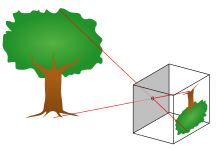
Pinhole camera. Low-cal enters a dark box through a small hole and creates an inverted image on the wall opposite the hole.[1]
Ibn al-Haytham (c. 965–1040 AD), an Arab physicist likewise known as Alhazen, wrote very influential essays about the camera obscura, including experiments with light through a minor opening in a darkened room.[two] The invention of the camera has been traced back to the work of Ibn al-Haytham,[3] who is credited with the invention of the pinhole camera.[iv] While the furnishings of a unmarried light passing through a pinhole had been described earlier,[3] Ibn al-Haytham gave the offset correct assay of the camera obscura,[5] including the offset geometrical and quantitative descriptions of the phenomenon,[6] and was the first to employ a screen in a nighttime room so that an image from one side of a pigsty in the surface could be projected onto a screen on the other side.[vii] He as well first understood the human relationship between the focal indicate and the pinhole,[8] and performed early experiments with afterimage.
Ibn al-Haytam's writings on eyes became very influential in Europe through Latin translations, inspiring people such as Witelo, John Peckham, Roger Bacon, Leonardo da Vinci, René Descartes and Johannes Kepler.[2] Camera Obscura were used as drawing aids since at least circa 1550. Since the tardily 17th century, portable camera obscura devices in tents and boxes were used as drawing aids.[ citation needed ]
Early on photographic camera (18th–19th centuries) [edit]
Earlier the development of the photographic camera, it had been known for hundreds of years that some substances, such as silvery salts, darkened when exposed to sunlight.[9] : 4 In a series of experiments, published in 1727, the High german scientist Johann Heinrich Schulze demonstrated that the darkening of the salts was due to lite alone, and non influenced by heat or exposure to air.[ten] : 7 The Swedish chemist Carl Wilhelm Scheele showed in 1777 that silver chloride was specially susceptible to darkening from lite exposure, and that once darkened, it becomes insoluble in an ammonia solution.[10] The commencement person to use this chemical science to create images was Thomas Wedgwood.[9] To create images, Wedgwood placed items, such as leaves and insect wings, on ceramic pots coated with silver nitrate, and exposed the fix-up to light. These images weren't permanent, notwithstanding, every bit Wedgwood didn't utilize a fixing machinery. He ultimately failed at his goal of using the process to create fixed images created past a camera obscura.[10] : 8
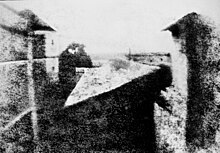
The first permanent photo of a camera image was made in 1825 by Joseph Nicéphore Niépce using a sliding wooden box photographic camera made by Charles and Vincent Chevalier in Paris.[10] : 9–xi Niépce had been experimenting with ways to set the images of a camera obscura since 1816. The photograph Niépce succeeded in creating shows the view from his window. It was made using an 8-hour exposure on pewter coated with bitumen.[ten] : 9 Niépce chosen his process "heliography".[9] : v Niépce corresponded with the inventor Louis-Jacques-Mandé Daguerre, and the pair entered into a partnership to improve the heliographic process. Niépce had experimented further with other chemicals, to meliorate dissimilarity in his heliographs. Daguerre contributed an improved camera obscura design, only the partnership ended when Niépce died in 1833.[ten] : ten Daguerre succeeded in developing a high-contrast and extremely precipitous image by exposing on a plate coated with silvery iodide, and exposing this plate once more to mercury vapor.[nine] : 6 By 1837, he was able to fix the images with a common salt solution. He called this process Daguerreotype, and tried unsuccessfully for a couple of years to commercialize it. Eventually, with assistance of the scientist and politician François Arago, the French government acquired Daguerre's process for public release. In commutation, pensions were provided to Daguerre besides every bit Niépce'southward son, Isidore.[10] : 11
In the 1830s, the English scientist William Henry Play a trick on Talbot independently invented a process to capture photographic camera images using silver salts.[11] : 15 Although dismayed that Daguerre had beaten him to the annunciation of photography, he submitted on Jan 31, 1839, a pamphlet to the Royal Establishment entitled Some Business relationship of the Fine art of Photogenic Drawing, which was the first published description of photography. Inside two years, Talbot adult a 2-stride procedure for creating photographs on paper, which he called calotypes. The calotype procedure was the first to use negative press, which reverses all values in the reproduction process – black shows up as white and vice versa.[9] : 21 Negative printing allows, in principle, an unlimited number of positive prints to be made from the original negative.[xi] : sixteen The Calotype procedure as well introduced the ability for a printmaker to alter the resulting epitome through retouching of the negative.[11] : 67 Calotypes were never as popular or widespread as daguerreotypes,[ix] : 22 owing mainly to the fact that the latter produced sharper details.[12] : 370 However, because daguerreotypes only produce a direct positive print, no duplicates can be made. It is the 2-footstep negative/positive procedure that formed the footing for modern photography.[10] : xv

The Giroux daguerreotype camera made by Maison Susse Frères in 1839, with a lens by Charles Chevalier, the first to be commercially produced[nine] : 9
The first photographic camera developed for commercial manufacture was a daguerreotype camera, built past Alphonse Giroux in 1839. Giroux signed a contract with Daguerre and Isidore Niépce to produce the cameras in France,[ix] : 8–nine with each device and accessories costing 400 francs.[thirteen] : 38 The camera was a double-box design, with a landscape lens fitted to the outer box, and a holder for a ground drinking glass focusing screen and prototype plate on the inner box. By sliding the inner box, objects at various distances could be brought to every bit sharp a focus as desired. After a satisfactory image had been focused on the screen, the screen was replaced with a sensitized plate. A knurled cycle controlled a copper flap in forepart of the lens, which functioned as a shutter. The early daguerreotype cameras required long exposure times, which in 1839 could be from 5 to 30 minutes.[9] [13] : 39
After the introduction of the Giroux daguerreotype camera, other manufacturers quickly produced improved variations. Charles Chevalier, who had earlier provided Niépce with lenses, created in 1841 a double-box camera using a half-sized plate for imaging. Chevalier's camera had a hinged bed, assuasive for one-half of the bed to fold onto the back of the nested box. In add-on to having increased portability, the camera had a faster lens, bringing exposure times down to 3 minutes, and a prism at the front of the lens, which allowed the prototype to be laterally correct.[14] : 6 Some other French pattern emerged in 1841, created by Marc Antoine Gaudin. The Nouvel Appareil Gaudin camera had a metal disc with three differently-sized holes mounted on the front of the lens. Rotating to a different hole finer provided variable f-stops, allowing dissimilar amounts of light into the camera.[15] : 28 Instead of using nested boxes to focus, the Gaudin photographic camera used nested brass tubes.[14] : 7 In Frg, Peter Friedrich Voigtländer designed an all-metallic photographic camera with a conical shape that produced circular pictures of about three inches in bore. The distinguishing feature of the Voigtländer camera was its use of a lens designed past Joseph Petzval.[xi] : 34 The f/3.5 Petzval lens was almost xxx times faster than whatsoever other lens of the period, and was the first to be made specifically for portraiture. Its blueprint was the most widely used for portraits until Carl Zeiss introduced the anastigmat lens in 1889.[10] : 19
Within a decade of being introduced in America, 3 general forms of camera were in popular use: the American- or chamfered-box camera, the Robert'southward-blazon camera or "Boston box", and the Lewis-type camera. The American-box camera had beveled edges at the front and rear, and an opening in the rear where the formed image could be viewed on ground glass. The acme of the photographic camera had hinged doors for placing photographic plates. Within there was one available slot for afar objects, and another slot in the back for close-ups. The lens was focused either by sliding or with a rack and pinion mechanism. The Robert's-type cameras were like to the American-box, except for having a knob-fronted worm gear on the front of the photographic camera, which moved the back box for focusing. Many Robert'due south-type cameras allowed focusing directly on the lens mountain. The third popular daguerreotype camera in America was the Lewis-type, introduced in 1851, which utilized a bellows for focusing. The main trunk of the Lewis-type camera was mounted on the forepart box, but the rear department was slotted into the bed for like shooting fish in a barrel sliding. Once focused, a fix screw was tightened to hold the rear department in place.[15] : 26–27 Having the bellows in the middle of the trunk facilitated making a 2nd, in-camera re-create of the original image.[14] : 17
Daguerreotype cameras formed images on silvered copper plates and images were simply able to develop with mercury vapor.[16] The earliest daguerreotype cameras required several minutes to one-half an hour to expose images on the plates. By 1840, exposure times were reduced to just a few seconds attributable to improvements in the chemical preparation and development processes, and to advances in lens design.[17] : 38 American daguerreotypists introduced manufactured plates in mass production, and plate sizes became internationally standardized: whole plate (half dozen.5 x eight.five inches), three-quarter plate (v.5 x seven one/8 inches), half plate (iv.5 x 5.5 inches), quarter plate (3.25 10 4.25 inches), 6th plate (2.75 ten 3.25 inches), and ninth plate (2 ten 2.v inches).[xi] : 33–34 Plates were oftentimes cut to fit cases and jewelry with round and oval shapes. Larger plates were produced, with sizes such as 9 x 13 inches ("double-whole" plate), or 13.5 10 16.5 inches (Southworth & Hawes' plate).[15] : 25
The collodion wet plate process that gradually replaced the daguerreotype during the 1850s required photographers to coat and sensitize thin glass or iron plates shortly before use and betrayal them in the camera while nevertheless wet. Early moisture plate cameras were very simple and petty dissimilar from Daguerreotype cameras, simply more sophisticated designs eventually appeared. The Dubroni of 1864 immune the sensitizing and developing of the plates to exist carried out within the camera itself rather than in a carve up darkroom. Other cameras were fitted with multiple lenses for photographing several small-scale portraits on a unmarried larger plate, useful when making cartes de visite. Information technology was during the wet plate era that the employ of bellows for focusing became widespread, making the bulkier and less hands adjusted nested box blueprint obsolete.
For many years, exposure times were long enough that the photographer simply removed the lens cap, counted off the number of seconds (or minutes) estimated to be required by the lighting weather, then replaced the cap. As more sensitive photographic materials became available, cameras began to contain mechanical shutter mechanisms that allowed very short and accurately timed exposures to exist fabricated.
The use of photographic moving picture was pioneered by George Eastman, who started manufacturing paper moving-picture show in 1885 before switching to celluloid in 1889. His first camera, which he called the "Kodak," was start offered for auction in 1888. Information technology was a very simple box camera with a fixed-focus lens and unmarried shutter speed, which along with its relatively low toll appealed to the average consumer. The Kodak came pre-loaded with enough moving picture for 100 exposures and needed to be sent back to the factory for processing and reloading when the curl was finished. By the end of the 19th century Eastman had expanded his lineup to several models including both box and folding cameras.
Films likewise made possible capture of motion (cinematography) establishing the movie industry by the end of the 19th century.
Early fixed images [edit]
The first partially successful photograph of a camera paradigm was made in approximately 1816 past Nicéphore Niépce,[18] [19] using a very modest camera of his own making and a piece of paper coated with silvery chloride, which darkened where it was exposed to light. No means of removing the remaining unaffected silvery chloride was known to Niépce, so the photo was not permanent, eventually condign entirely darkened past the overall exposure to light necessary for viewing information technology. In the mid-1820s, Niépce used a sliding wooden box camera made by Parisian opticians Charles and Vincent Chevalier, to experiment with photography on surfaces thinly coated with Bitumen of Judea.[20] The bitumen slowly hardened in the brightest areas of the epitome. The unhardened bitumen was then dissolved away. One of those photographs has survived.
Daguerreotypes and calotypes [edit]
After Niépce'south expiry in 1830, his partner Louis Daguerre continued to experiment and by 1837 had created the first practical photographic process, which he named the daguerreotype and publicly unveiled in 1839.[21] Daguerre treated a silver-plated canvass of copper with iodine vapor to give it a coating of low-cal-sensitive silver iodide. Subsequently exposure in the camera, the epitome was adult by mercury vapor and fixed with a strong solution of ordinary salt (sodium chloride). Henry Fox Talbot perfected a unlike process, the calotype, in 1840. As commercialized, both processes used very simple cameras consisting of two nested boxes. The rear box had a removable basis glass screen and could slide in and out to adjust the focus. After focusing, the ground glass was replaced with a light-tight holder containing the sensitized plate or paper and the lens was capped. Then the photographer opened the front encompass of the holder, uncapped the lens, and counted off as many minutes equally the lighting conditions seemed to require before replacing the cap and closing the holder. Despite this mechanical simplicity, high-quality achromatic lenses were standard.[22]

Late 19th-century studio camera
Dry plates [edit]
Collodion dry plates had been bachelor since 1857, cheers to the work of Désiré van Monckhoven, merely it was not until the invention of the gelatin dry plate in 1871 past Richard Leach Maddox that the wet plate process could be rivaled in quality and speed. The 1878 discovery that oestrus-ripening a gelatin emulsion greatly increased its sensitivity finally made so-chosen "instantaneous" snapshot exposures practical. For the first time, a tripod or other back up was no longer an absolute necessity. With daylight and a fast plate or film, a small photographic camera could be hand-held while taking the picture. The ranks of amateur photographers swelled and informal "aboveboard" portraits became popular. There was a proliferation of camera designs, from single- and twin-lens reflexes to large and bulky field cameras, simple box cameras, and even "detective cameras" bearded as pocket watches, hats, or other objects.
The brusque exposure times that made candid photography possible also necessitated another innovation, the mechanical shutter. The very start shutters were split up accessories, though born shutters were mutual by the end of the 19th century.[22]
Invention of photographic film [edit]
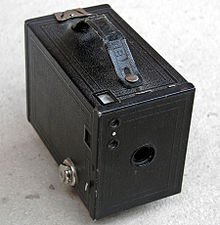
Kodak No. 2 Brownie box camera, circa 1920
The use of photographic motion picture was pioneered by George Eastman, who started manufacturing paper film in 1885 earlier switching to celluloid in 1888–1889. His outset camera, which he called the "Kodak", was commencement offered for sale in 1888. It was a very uncomplicated box photographic camera with a fixed-focus lens and single shutter speed, which along with its relatively low price appealed to the average consumer. The Kodak came pre-loaded with enough picture show for 100 exposures and needed to be sent dorsum to the factory for processing and reloading when the gyre was finished. By the end of the 19th century Eastman had expanded his lineup to several models including both box and folding cameras.
In 1900, Eastman took mass-market photography 1 step further with the Brownie, a simple and very inexpensive box photographic camera that introduced the concept of the snapshot. The Credibility was extremely popular and various models remained on sale until the 1960s.
Film likewise allowed the movie camera to develop from an expensive toy to a practical commercial tool.
Despite the advances in low-toll photography made possible by Eastman, plate cameras even so offered higher-quality prints and remained popular well into the 20th century. To compete with rollfilm cameras, which offered a larger number of exposures per loading, many inexpensive plate cameras from this era were equipped with magazines to hold several plates at one time. Special backs for plate cameras allowing them to utilise flick packs or rollfilm were also bachelor, as were backs that enabled rollfilm cameras to apply plates.
Except for a few special types such equally Schmidt cameras, most professional astrographs continued to use plates until the end of the 20th century when electronic photography replaced them.
35 mm [edit]
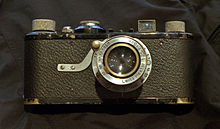

A number of manufacturers started to employ 35 mm film for nevertheless photography between 1905 and 1913. The first 35 mm cameras bachelor to the public, and reaching meaning numbers in sales were the Tourist Multiple, in 1913, and the Simplex, in 1914.[ commendation needed ]
Oskar Barnack, who was in accuse of enquiry and development at Leitz, decided to investigate using 35 mm cine motion picture for yet cameras while attempting to build a compact camera capable of making high-quality enlargements. He built his prototype 35 mm camera (Ur-Leica) around 1913, though further evolution was delayed for several years by World War I. Information technology wasn't until after Earth War I that Leica commercialized their first 35 mm cameras. Leitz test-marketed the design between 1923 and 1924, receiving enough positive feedback that the camera was put into production as the Leica I (for Leitz camera) in 1925. The Leica's firsthand popularity spawned a number of competitors, most notably the Contax (introduced in 1932), and cemented the position of 35 mm as the format of choice for loftier-cease compact cameras.
Kodak got into the market with the Retina I in 1934, which introduced the 135 cartridge used in all modern 35 mm cameras. Although the Retina was comparatively inexpensive, 35 mm cameras were even so out of reach for most people and rollfilm remained the format of pick for mass-market cameras. This inverse in 1936 with the introduction of the cheap Argus A and to an fifty-fifty greater extent in 1939 with the arrival of the immensely popular Argus C3. Although the cheapest cameras still used rollfilm, 35 mm flick had come to dominate the market by the fourth dimension the C3 was discontinued in 1966.
The fledgling Japanese camera industry began to take off in 1936 with the Canon 35 mm rangefinder, an improved version of the 1933 Kwanon paradigm. Japanese cameras would begin to go pop in the Due west after Korean War veterans and soldiers stationed in Japan brought them back to the U.s. and elsewhere.
TLRs and SLRs [edit]
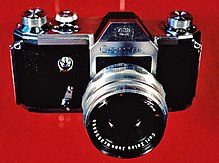
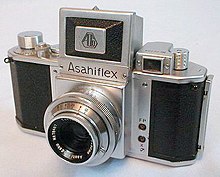

The first practical reflex camera was the Franke & Heidecke Rolleiflex medium format TLR of 1928. Though both single- and twin-lens reflex cameras had been available for decades, they were also beefy to achieve much popularity. The Rolleiflex, notwithstanding, was sufficiently compact to achieve widespread popularity and the medium-format TLR design became popular for both loftier- and depression-end cameras.
A similar revolution in SLR blueprint began in 1933 with the introduction of the Ihagee Exakta, a meaty SLR which used 127 rollfilm. This was followed three years later by the beginning Western SLR to use 135 film, the Kine Exakta (Earth's first truthful 35mm SLR was Soviet "Sport" camera, marketed several months earlier Kine Exakta, though "Sport" used its ain film cartridge). The 35mm SLR pattern gained firsthand popularity and there was an explosion of new models and innovative features after Globe State of war Two. There were also a few 35 mm TLRs, the best-known of which was the Contaflex of 1935, but for the near part these met with trivial success.
The first major mail-state of war SLR innovation was the eye-level viewfinder, which starting time appeared on the Hungarian Duflex in 1947 and was refined in 1948 with the Contax South, the first camera to use a pentaprism. Prior to this, all SLRs were equipped with waist-level focusing screens. The Duflex was also the first SLR with an instant-return mirror, which prevented the viewfinder from being blacked out after each exposure. This aforementioned time period besides saw the introduction of the Hasselblad 1600F, which set the standard for medium format SLRs for decades.
In 1952 the Asahi Optical Visitor (which later on became well known for its Pentax cameras) introduced the start Japanese SLR using 135 film, the Asahiflex. Several other Japanese camera makers too entered the SLR market in the 1950s, including Canon, Yashica, and Nikon. Nikon's entry, the Nikon F, had a full line of interchangeable components and accessories and is more often than not regarded as the showtime Japanese system camera. It was the F, along with the earlier S series of rangefinder cameras, that helped establish Nikon'southward reputation as a maker of professional person-quality equipment and one of the globe'due south best known brands.
Instant cameras [edit]

While conventional cameras were becoming more refined and sophisticated, an entirely new blazon of camera appeared on the market in 1948. This was the Polaroid Model 95, the world'due south get-go feasible instant-picture camera. Known as a Land Photographic camera after its inventor, Edwin Land, the Model 95 used a patented chemical process to produce finished positive prints from the exposed negatives in under a minute. The State Camera caught on despite its relatively loftier price and the Polaroid lineup had expanded to dozens of models by the 1960s. The first Polaroid camera aimed at the pop market place, the Model 20 Swinger of 1965, was a huge success and remains one of the pinnacle-selling cameras of all fourth dimension.
Automation [edit]
The first camera to feature automated exposure was the selenium light meter-equipped, fully automatic Super Kodak Six-xx pack of 1938, only its extremely loftier price (for the time) of $225 (equivalent to $4,137 in 2020)[23] kept it from achieving whatsoever caste of success. By the 1960s, however, low-cost electronic components were commonplace and cameras equipped with light meters and automatic exposure systems became increasingly widespread.
The next technological accelerate came in 1960, when the German Mec 16 SB subminiature became the first camera to identify the light meter behind the lens for more than authentic metering. All the same, through-the-lens metering ultimately became a characteristic more usually found on SLRs than other types of camera; the first SLR equipped with a TTL system was the Topcon RE Super of 1962.
Digital cameras [edit]
Digital cameras differ from their analog predecessors primarily in that they do non use pic, just capture and save photographs on digital retentiveness cards or internal storage instead. Their depression operating costs accept relegated chemical cameras to niche markets. Digital cameras now include wireless communication capabilities (for case Wi-Fi or Bluetooth) to transfer, print, or share photos, and are normally found on mobile phones.
Digital imaging applied science [edit]
The kickoff semiconductor epitome sensor was the CCD, invented by Willard S. Boyle and George Eastward. Smith at Bong Labs in 1969.[24] While researching MOS technology, they realized that an electric charge was the analogy of the magnetic bubble and that it could be stored on a tiny MOS capacitor. As it was fairly straightforward to fabricate a serial of MOS capacitors in a row, they continued a suitable voltage to them so that the charge could be stepped along from 1 to the next.[25] The CCD is a semiconductor circuit that was later used in the kickoff digital video cameras for television broadcasting.[26]
The NMOS active-pixel sensor (APS) was invented by Olympus in Japan during the mid-1980s. This was enabled by advances in MOS semiconductor device fabrication, with MOSFET scaling reaching smaller micron and then sub-micron levels.[27] [28] The NMOS APS was fabricated by Tsutomu Nakamura's team at Olympus in 1985.[29] The CMOS active-pixel sensor (CMOS sensor) was later developed by Eric Fossum's team at the NASA Jet Propulsion Laboratory in 1993.[30] [27]
Early digital camera prototypes [edit]
The concept of digitizing images on scanners, and the concept of digitizing video signals, predate the concept of making withal pictures by digitizing signals from an assortment of discrete sensor elements. Early spy satellites used the extremely complex and expensive method of de-orbit and airborne retrieval of picture show canisters. Engineering was pushed to skip these steps through the use of in-satellite developing and electronic scanning of the film for direct transmission to the basis. The amount of moving-picture show was still a major limitation, and this was overcome and greatly simplified past the push to develop an electronic image capturing array that could be used instead of film. The first electronic imaging satellite was the KH-eleven launched by the NRO in late 1976. It had a accuse-coupled device (CCD) array with a resolution of 800 x 800 pixels (0.64 megapixels).[31] At Philips Labs in New York, Edward Stupp, Pieter Cath and Zsolt Szilagyi filed for a patent on "All Solid State Radiations Imagers" on six September 1968 and synthetic a apartment-screen target for receiving and storing an optical prototype on a matrix composed of an array of photodiodes connected to a capacitor to course an array of two terminal devices connected in rows and columns. Their U.s.a. patent was granted on x November 1970.[32] Texas Instruments engineer Willis Adcock designed a filmless camera that was non digital and applied for a patent in 1972, just information technology is non known whether it was ever built.[33]
The Cromemco Cyclops, introduced as a hobbyist construction project in 1975,[34] was the offset digital camera to be interfaced to a microcomputer. Its prototype sensor was a modified metallic-oxide-semiconductor (MOS) dynamic RAM (DRAM) memory scrap.[35]
The first recorded attempt at edifice a self-contained digital camera was in 1975 by Steven Sasson, an engineer at Eastman Kodak.[36] [37] It used the then-new solid-state CCD image sensor chips developed past Fairchild Semiconductor in 1973.[38] The photographic camera weighed viii pounds (three.6 kg), recorded black-and-white images to a compact cassette tape, had a resolution of 0.01 megapixels (10,000 pixels), and took 23 seconds to capture its first image in December 1975. The epitome photographic camera was a technical practise, not intended for product.
Analog electronic cameras [edit]

Handheld electronic cameras, in the sense of a device meant to be carried and used as a handheld film camera, appeared in 1981 with the sit-in of the Sony Mavica (Magnetic Video Photographic camera). This is non to be confused with the later cameras by Sony that as well bore the Mavica name. This was an analog camera, in that it recorded pixel signals continuously, as videotape machines did, without converting them to discrete levels; it recorded television-like signals to a 2 × ii inch "video floppy".[39] In essence, information technology was a video moving picture camera that recorded single frames, l per deejay in field mode, and 25 per disk in frame fashion. The image quality was considered equal to that of then-current televisions.
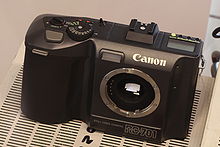
Analog electronic cameras do not appear to accept reached the market until 1986 with the Canon RC-701. Canon demonstrated a prototype of this model at the 1984 Summer Olympics, press the images in the Yomiuri Shinbun, a Japanese newspaper. In the United states, the offset publication to utilize these cameras for real reportage was USA Today, in its coverage of World Series baseball. Several factors held back the widespread adoption of analog cameras; the cost (upwards of $xx,000, equivalent to $47,000 in 2020[23]), poor image quality compared to film, and the lack of quality affordable printers. Capturing and press an image originally required access to equipment such every bit a frame grabber, which was beyond the achieve of the average consumer. The "video floppy" disks afterwards had several reader devices available for viewing on a screen but were never standardized as a computer bulldoze.
The early on adopters tended to be in the news media, where the cost was negated past the utility and the ability to transmit images by telephone lines. The poor image quality was offset by the low resolution of newspaper graphics. This capability to transmit images without a satellite link was useful during the 1989 Tiananmen Foursquare protests and the beginning Gulf War in 1991.
The states government agencies too took a strong interest in the still video concept, notably the U.s. Navy for apply every bit a real-time air-to-sea surveillance system.
The first analog electronic camera marketed to consumers may take been the Casio VS-101 in 1987. A notable analog camera produced the aforementioned year was the Nikon QV-1000C, designed as a printing camera and not offered for sale to general users, which sold merely a few hundred units. It recorded images in greyscale, and the quality in paper print was equal to moving picture cameras. In appearance it closely resembled a modern digital single-lens reflex camera. Images were stored on video floppy disks.
Silicon Film, a proposed digital sensor cartridge for film cameras that would allow 35 mm cameras to take digital photographs without modification was announced in late 1998. Silicon Film was to work every bit a roll of 35 mm film, with a 1.3 megapixel sensor behind the lens and a battery and storage unit plumbing fixtures in the picture show holder in the camera. The product, which was never released, became increasingly obsolete due to improvements in digital camera technology and affordability. Silicon Films' parent company filed for bankruptcy in 2001.[forty]
Early true digital cameras [edit]

Minolta RD-175, the first portable digital SLR camera, introduced by Minolta in 1995.
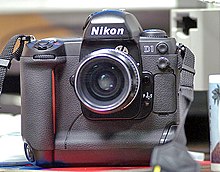
By the late 1980s, the technology required to produce truly commercial digital cameras existed. The first true portable digital photographic camera that recorded images equally a computerized file was likely the Fuji DS-1P of 1988, which recorded to a 2 MB SRAM (static RAM) retentiveness card that used a battery to keep the data in memory. This camera was never marketed to the public.
The starting time digital photographic camera of whatsoever kind ever sold commercially was possibly the MegaVision Tessera in 1987[41] though in that location is non extensive documentation of its auction known. The outset portable digital photographic camera that was really marketed commercially was sold in December 1989 in Japan, the DS-X by Fuji[42] The first commercially available portable digital camera in the Usa was the Dycam Model 1, first shipped in November 1990.[43] It was originally a commercial failure because it was blackness-and-white, low in resolution, and cost nearly $1,000 (equivalent to $2,000 in 2020[23]).[44] Information technology afterwards saw modest success when it was re-sold as the Logitech Fotoman in 1992. It used a CCD epitome sensor, stored pictures digitally, and connected directly to a computer for download.[45] [46] [47]
Digital SLRs (DSLRs) [edit]
Nikon was interested in digital photography since the mid-1980s. In 1986, while presenting to Photokina, Nikon introduced an operational prototype of the first SLR-type digital camera (Still Video Camera), manufactured by Panasonic.[48] The Nikon SVC was congenital around a sensor ii/three " charge-coupled device of 300,000 pixels. Storage media, a magnetic floppy inside the photographic camera allows recording 25 or 50 B&W images, depending on the definition.[49] In 1988, Nikon released the showtime commercial DSLR camera, the QV-1000C.[48]
In 1991, Kodak brought to market the Kodak DCS (Kodak Digital Photographic camera System), the beginning of a long line of professional Kodak DCS SLR cameras that were based in part on flick bodies, often Nikons. Information technology used a 1.3 megapixel sensor, had a bulky external digital storage system and was priced at $13,000 (equivalent to $25,000 in 2020[23]). At the arrival of the Kodak DCS-200, the Kodak DCS was dubbed Kodak DCS-100.
The movement to digital formats was helped past the formation of the get-go JPEG and MPEG standards in 1988, which immune image and video files to be compressed for storage. The showtime consumer camera with a liquid crystal display on the back was the Casio QV-x developed by a squad led by Hiroyuki Suetaka in 1995. The first photographic camera to utilize CompactFlash was the Kodak DC-25 in 1996.[50] The offset camera that offered the ability to record video clips may have been the Ricoh RDC-1 in 1995.
In 1995 Minolta introduced the RD-175, which was based on the Minolta 500si SLR with a splitter and three independent CCDs. This combination delivered i.75M pixels. The benefit of using an SLR base of operations was the power to use any existing Minolta AF mount lens. 1999 saw the introduction of the Nikon D1, a 2.74 megapixel camera that was the first digital SLR adult entirely from the ground up past a major manufacturer, and at a cost of nether $6,000 (equivalent to $10,200 in 2020[23]) at introduction was affordable by professional person photographers and high-end consumers. This camera also used Nikon F-mount lenses, which meant film photographers could utilize many of the same lenses they already owned.
Digital camera sales connected to flourish, driven by applied science advances. The digital marketplace segmented into different categories, Compact Digital Still Cameras, Bridge Cameras, Mirrorless Compacts and Digital SLRs.
Since 2003, digital cameras have outsold film cameras[51] and Kodak announced in January 2004 that they would no longer sell Kodak-branded motion-picture show cameras in the developed world[52] – and in 2012 filed for bankruptcy subsequently struggling to adapt to the changing industry.[53]
Photographic camera phones [edit]
The outset commercial camera telephone was the Kyocera Visual Phone VP-210, released in Japan in May 1999.[54] It was called a "mobile videophone" at the time,[55] and had a 110,000-pixel front-facing photographic camera.[54] It stored up to 20 JPEG digital images, which could be sent over east-mail, or the phone could transport up to 2 images per second over Japan's Personal Handy-phone System (PHS) cellular network.[54] The Samsung SCH-V200, released in South Korea in June 2000, was also ane of the first phones with a built-in photographic camera. It had a TFT liquid-crystal display (LCD) and stored upwardly to xx digital photos at 350,000-pixel resolution. However, it could not transport the resulting image over the telephone function, but required a computer connection to access photos.[56] The first mass-market camera phone was the J-SH04, a Sharp J-Phone model sold in Japan in November 2000.[57] [56] It could instantly transmit pictures via jail cell phone telecommunications.[58]
One of the major engineering advances was the development of CMOS sensors, which helped bulldoze sensor costs depression enough to enable the widespread adoption of photographic camera phones. Smartphones now routinely include high resolution digital cameras.
See also [edit]
- History of photography
- Photographic lens design
- Movie camera
References [edit]
- ^ Kirkpatrick, Larry D.; Francis, Gregory Due east. (2007). "Light". Physics: A World View (half-dozen ed.). Belmont, California: Thomson Brooks/Cole. p. 339. ISBN978-0-495-01088-three.
- ^ a b Plott, John C. (1984). Global History of Philosophy: The Menses of scholasticism (part ane). p. 460. ISBN978-0-89581-678-viii.
- ^ a b Belbachir, Ahmed Nabil (2010). Smart Cameras. Springer Science & Business concern Media. ISBN978-1-4419-0953-4.
The invention of the photographic camera can be traced back to the 10th century when the Arab scientist Al-Hasan Ibn al-Haytham alias Alhacen provided the first clear description and correct assay of the (human being) vision procedure. Although the furnishings of single light passing through the pinhole take already been described by the Chinese Mozi (Lat. Micius) (5th century B), the Greek Aristotle (quaternary century BC), and the Arab
- ^ Plott, John C. (1984). Global History of Philosophy: The Flow of scholasticism (part one). p. 460. ISBN978-0-89581-678-8.
According to Nazir Ahmed if only Ibn-Haitham's fellow-workers and students had been as alert as he, they might even have invented the art of photography since al-Haytham'southward experiments with convex and concave mirrors and his invention of the "pinhole camera" whereby the inverted epitome of a candle-flame is projected were among his many successes in experimentation. One might likewise about claim that he had anticipated much that the nineteenth century Fechner did in experimentation with after-images.
- ^ Wade, Nicholas J.; Finger, Stanley (2001), "The center as an optical instrument: from camera obscura to Helmholtz'southward perspective", Perception, 30 (10): 1157–1177, doi:x.1068/p3210, PMID 11721819, S2CID 8185797,
The principles of the camera obscura first began to be correctly analysed in the eleventh century, when they were outlined past Ibn al-Haytham.
- ^ Needham, Joseph. Science and Civilisation in Cathay, vol. Iv, part 1: Physics and Physical Applied science (PDF). p. 98. Archived from the original (PDF) on 3 July 2017. Retrieved 5 September 2016.
Alhazen used the camera obscura particularly for observing solar eclipses, equally indeed Aristotle is said to take washed, and information technology seems that, like Shen Kua, he had predecessors in its study, since he did not claim it as whatsoever new finding of his own. But his treatment of it was competently geometrical and quantitative for the first time.
- ^ "Who Invented Photographic camera Obscura?". Photography History Facts.
All these scientists experimented with a minor hole and light but none of them suggested that a screen is used so an image from one side of a hole on the surface could be projected at the screen on the other. Offset, ane to do so was Alhazen (too known as Ibn al-Haytham) in 11th century.
- ^ Needham, Joseph. Science and Civilization in Cathay, vol. IV, part 1: Physics and Concrete Technology (PDF). p. 99. Archived from the original (PDF) on iii July 2017. Retrieved 5 September 2016.
The genius of Shen Kua's insight into the relation of focal point and pinhole tin can better exist appreciated when we read in Singer that this was outset understood in Europe by Leonardo da Vinci (+ 1452 to + 1519), almost 5 hundred years later. A diagram showing the relation occurs in the Codice Atlantico, Leonardo thought that the lens of the centre reversed the pinhole effect, and so that the image did non appear inverted on the retina; though in fact, it does. Actually, the analogy of focal-point and pin-point must accept been understood by Ibn al-Haitham, who died just nearly the time when Shen Ku was built-in.
- ^ a b c d e f 1000 h i j Gustavson, Todd (2009). Photographic camera: a history of photography from daguerreotype to digital. New York: Sterling Publishing Co., Inc. ISBN978-i-4027-5656-six.
- ^ a b c d e f g h i Gernsheim, Helmut (1986). A Concise History of Photography (iii ed.). Mineola, New York: Dover Publications, Inc. ISBN978-0-486-25128-8.
- ^ a b c d due east Hirsch, Robert (2000). Seizing the Calorie-free: A History of Photography. New York: McGraw-Colina Companies, Inc. ISBN978-0-697-14361-7.
- ^ London, Barbara; Upton, John; Kobré, Kenneth; Brill, Betsy (2002). Photography (7 ed.). Upper Saddle River, New Jersey: Prentice Hall. ISBN978-0-13-028271-2.
- ^ a b Frizot, Michel (January 1998). "Light machines: On the threshold of invention". In Michel Frizot (ed.). A New History of Photography. Koln, Germany: Konemann. ISBN978-3-8290-1328-4.
- ^ a b c Gustavson, Todd (1 Nov 2011). 500 Cameras: 170 Years of Photographic Innovation. Toronto, Ontario: Sterling Publishing, Inc. ISBN978-1-4027-8086-eight.
- ^ a b c Spira, Southward.F.; Lothrop, Jr., Easton S.; Spira, Jonathan B. (2001). The History of Photography as Seen Through the Spira Collection. New York: Aperture. ISBN978-0-89381-953-eight.
- ^ "Daguerreotype". Scientific American. two (38): 302. 1847. doi:10.1038/scientificamerican06121847-302e. ISSN 0036-8733. JSTOR 24924116.
- ^ Starl, Timm (January 1998). "A New Earth of Pictures: The Daguerreotype". In Michel Frizot (ed.). A New History of Photography. Koln, Germany: Konemann. ISBN978-3-8290-1328-4.
- ^ Newhall, Beaumont (1982). The History of Photography. New York, New York: The Museum of Mod Art. p. 13. ISBN0-87070-381-i.
Joseph Nicéphore Niépce, of exposure to light. Although the simply instance of his camera work that remains today appears to have been made in 1826, his letters get out no doubt that he had succeeded in fixing the camera'southward image a decade earlier.
- ^ Leslie Stroebel and Richard D. Zakia (1993). The Focal encyclopedia of photography (third ed.). Focal Press. p. half-dozen. ISBN978-0-240-51417-eight.
- ^ Davenport, Alma (1999). The history of photography: an overview. Albuquerque, NM: University of New Mexico Press. p. 6. ISBN0-8263-2076-7.
- ^ Kosinski Dorothy, The Artist and the Camera, Degas to Picasso. New Haven: Yale University Press,1999. p.25
- ^ a b Wade, John (1979). A Short History of the Camera. Watford: Fountain Press. ISBN0-85242-640-two.
- ^ a b c d eastward 1634–1699: McCusker, J. J. (1997). How Much Is That in Real Money? A Historical Price Index for Use every bit a Deflator of Money Values in the Economy of the The states: Addenda et Corrigenda (PDF). American Antiquarian Order. 1700–1799: McCusker, J. J. (1992). How Much Is That in Existent Money? A Historical Cost Index for Apply every bit a Deflator of Money Values in the Economy of the U.s.a. (PDF). American Antiquarian Society. 1800–present: Federal Reserve Banking concern of Minneapolis. "Consumer Price Index (guess) 1800–". Retrieved 1 January 2020.
- ^ James R. Janesick (2001). Scientific charge-coupled devices. SPIE Press. pp. three–4. ISBN978-0-8194-3698-6.
- ^ Williams, J. B. (2017). The Electronics Revolution: Inventing the Future. Springer. pp. 245–8. ISBN9783319490885.
- ^ Boyle, William S; Smith, George E. (1970). "Charge Coupled Semiconductor Devices". Bell Syst. Tech. J. 49 (4): 587–593. doi:10.1002/j.1538-7305.1970.tb01790.x.
- ^ a b Fossum, Eric R. (12 July 1993). Blouke, Morley Yard. (ed.). "Active pixel sensors: are CCDs dinosaurs?". SPIE Proceedings Vol. 1900: Charge-Coupled Devices and Solid Land Optical Sensors III. International Guild for Eyes and Photonics. 1900: two–fourteen. Bibcode:1993SPIE.1900....2F. CiteSeerXten.i.one.408.6558. doi:x.1117/12.148585. S2CID 10556755.
- ^ Fossum, Eric R. (2007). "Agile Pixel Sensors" (PDF). Semantic Scholar. S2CID 18831792. Archived from the original (PDF) on 9 March 2019. Retrieved viii October 2019.
- ^ Matsumoto, Kazuya; et al. (1985). "A new MOS phototransistor operating in a non-destructive readout mode". Japanese Journal of Applied Physics. 24 (5A): L323. Bibcode:1985JaJAP..24L.323M. doi:10.1143/JJAP.24.L323.
- ^ Fossum, Eric R.; Hondongwa, D. B. (2014). "A Review of the Pinned Photodiode for CCD and CMOS Image Sensors". IEEE Journal of the Electron Devices Club. 2 (iii): 33–43. doi:10.1109/JEDS.2014.2306412.
- ^ globalsecurity.org – KH-eleven KENNAN, 24 April 2007
- ^ U.s. 3540011
- ^ US 4057830 and US 4163256 were filed in 1972 but were just later awarded in 1976 and 1977. "1970s". Retrieved xv June 2008.
- ^ Walker, Terry; Garland, Harry; Melen, Roger (Feb 1975). "Build Cyclops". Popular Electronics. Ziff Davis. 7 (2): 27–31.
- ^ Benchoff, Brian (17 April 2016). "Building the First Digital Camera". Hackaday . Retrieved thirty April 2016.
the Cyclops was the kickoff digital camera
- ^ "Digital Photography Milestones from Kodak". Women in Photography International . Retrieved 17 September 2007.
- ^ "Kodak blog: We Had No Thought". Archived from the original on 29 May 2010.
- ^ Michael R. Peres (2007). The Focal Encyclopedia of Photography (4th ed.). Focal Press. ISBN978-0-240-80740-9.
- ^ Kenji Toyoda (2006). "Digital Still Cameras at a Glance". In Junichi Nakamura (ed.). Image sensors and betoken processing for digital yet cameras. CRC Press. p. 5. ISBN978-0-8493-3545-vii.
- ^ Askey, Phil (2001). "Silicon Film – vaporized-ware". Retrieved xx February 2008.
- ^ "MegaVision Professional Photographic camera Backs".
- ^ History of the digital camera and digital imaging
- ^ "Digital cameras, the next wave. (Electronic Imaging Issue; includes related manufactures) | HighBeam Business: Make it Prepared". Archived from the original on 3 May 2014.
- ^ Inc, InfoWorld Media Group (12 August 1991). "InfoWorld". InfoWorld Media Group, Inc. – via Google Books.
- ^ "History of the digital camera and digital imaging". The Digital Camera Museum.
- ^ "Dycam Model one: The world'due south first consumer digital yet camera". DigiBarn estimator museum.
- ^ Carolyn Said, "DYCAM Model 1: The first portable Digital Yet Camera", MacWeek, vol. 4, No. 35, 16 Oct. 1990, p. 34.
- ^ a b David D. Busch (2011), Nikon D70 Digital Field Guide, folio xi, John Wiley & Sons
- ^ Nikon SLR-blazon digital cameras, Pierre Jarleton
- ^ "Kodak DC25 (1996)". DigitalKamera Museum.
- ^ "Digital outsells film, but pic still king to some". Macworld. 23 September 2004.
- ^ Smith, Tony (20 Jan 2004). "Kodak to drop 35 mm cameras in Europe, United states of america". The Register. Retrieved 3 Apr 2007.
- ^ "Eastman Kodak Files for Defalcation". The New York Times. 19 January 2012.
- ^ a b c "Photographic camera phones: A look back and forward". Computerworld. 11 May 2012. Retrieved fifteen September 2019.
- ^ "Outset mobile videophone introduced". CNN. eighteen May 1999. Retrieved fifteen September 2019.
- ^ a b "From J-Telephone to Lumia 1020: A complete history of the camera phone". Digital Trends. 11 August 2013. Retrieved 15 September 2019.
- ^ "Evolution of the Camera telephone: From Abrupt J-SH04 to Nokia 808 Pureview". Hoista.net. 28 February 2012. Archived from the original on 31 July 2013. Retrieved 21 June 2013.
- ^ "Taking pictures with your telephone". BBC News. BBC. xviii September 2001. Retrieved 15 September 2019.
External links [edit]
- [1] The Digital Photographic camera Museum, with history department
- [ii] The Definitive Complete History of the Camera
Source: https://en.wikipedia.org/wiki/History_of_the_camera
Posted by: schmidtfassescarde52.blogspot.com


0 Response to "When Was A Camera Invented"
Post a Comment